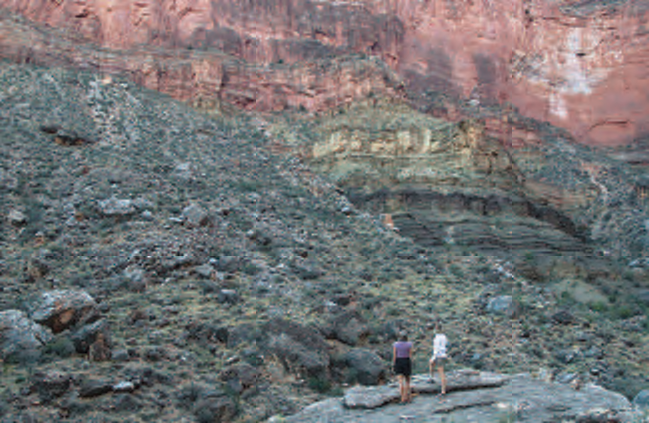Biologists Strive to Help Condors Succeed

From extinction. In 1987, the wildlife agency took the remnant birds into captivity to save the species.
Through a joint effort of Fish and Wildlife, The Peregrine Fund, Arizona Game and Fish, Grand Canyon National Park, the Bureau of Land Management and other partners, condors got a chance to fly in Arizona skies again. In 1996, the agencies released six birds 3 miles north of U.S. Route 89A on House Rock Valley Road, a ribbon of red clay in a sea of sage that parallels the Vermilion Cliffs. The site, remote and full of the condors' favorite foods of carrion of cattle, deer and elk, presented the condors' preferred habitat of sheer cliffs. Also, ancient remains of condors found in the Grand Canyon indicated the birds had a former connection with the area.
Today, Arizona has 41 free-flying condors, and many have made the Grand Canyon their stronghold. The reintroduced birds have plenty of help from the agencies' dedicated crew of wildlife biologists.
A cross between guardian angels and nurses, the biologists have kept a constant vigil on the birds. During the day, the biologists sit and watch from the release point along House Rock Valley Road and take meticulous notes on the birds' activities. They follow the condors around the countryside on the North Kaibab Plateau and South Rim of the Grand Canyon, keeping watch over the birds lest the newbies get into a perilous predicament.
To facilitate management and observation, the biologists ensure that Vermilion Cliffs remain a "home base" by hauling 40-pound pails of water a half-mile across a sandy trail atop the cliffs to provide a reliable drinking spot for the birds. At night, the biologists make sure the newly released birds roost out of harm's way. Sometimes that means climbing up a precipitous canyon during a rainstorm to shoo a condor from a sitting-duck roost to a safer perch out of reach of coyotes. Later, the attentive scientists tuck the birds' favorite meal near a juniper: bloated stillborn calves procured from several dairies in the Phoenix Valley.
Without condor parents to give them correct examples of what to do, some of the reintroduced condors occasionally make poor decisions. Naysayers of the restoration program have insisted this inept behavior would prove the program a flop. With Baby Condor Number 305 arriving on the scene, the reintroduction program has taken a new turn.
"The chick's successful hatching is one of the biggest steps in the entire process," said Chris Parish, project manager for the California Condor Restoration Project with The Peregrine Fund. "It's the beginning of the next step-wild condors produced in the wild. This event says the birds can be hatched in captivity, released as juveniles and reproduce in the wild. They have enough innate information to make it."
Though the condors rank among the most-monitored creatures in the universe, more than a week had gone by without anyone hiking into the canyon to observe Baby Condor 305. No one knew if the chick was dead or alive. This gave Rogers the jitters. The 12-mile hike to camp, located in an area of a South Rim side canyon called The Inferno, ended at nightfall. Rogers would once again have to go to bed worrying about her charge before she could head up to the observation rock to view Arizona's baby condor the next day.
Viewing the chick, like the rest of the responsibilities of the reintroduction program, did not come without hard work and some precarious moments. The observation rock, an outcropping of sandstone jutting from the bottom of the vertical Redwall formation, required a climb of 700 feet in .2 of a mile up a treacherous limestone and shale talus slope. But first, Rogers and MacVean had to take precautions at camp, noting the condors' proclivity to engage in behavior such as tearing apart tents or backpacks. Some, especially the younger birds, periodically take food from tourists and occasionally cause a ruckus at campgrounds. The condors' mission is not to seek and destroy. Rather, the birds have an inquisitive nature that tilts to the playful.
Parish says: "Condors like to play with things-sticks, cans, garbage and especially colorful stuff. In captivity, we've watched them play with a 2-liter bottle, tossing it over their heads like a puppy, then running after it to kick it."
While some of the juveniles attract unwanted attention with their delinquent behavior, condors generally stay away from the crowds.
After the hair-raising climb up to the observation rock, Rogers set up a high-powered spotting scope to view the nest, a cave in the Redwall formation about .3 of a mile away that looked like an indistinct crack. At the beginning of her all-day vigil, she found the chick alive and well, standing in the mouth of the cave.
Baby Condor, born sometime in March 2003, stayed in the back of the cave, out of sight, until August 15. Before then, the researchers could tell the First Parents had lain an egg by their roosting activities. They also knew about when the egg had hatched by the general change in frequency of time spent at the nest cave. The parents actively attended to their chick the first few months with snuggles and meals. Now, with the chick almost full-grown at just over 5 months old, the parents showed up only to feed it. Recently, the visit usually lasted only about six minutes every other day-enough time to swoop into the cave, feed the chick, and leave.
Condor mealtime has a distinctive frenzy to it, much like a rugby scrum, with a group of birds pushing and kicking to get to the carrion. Baby Condor's meals had the same frenetic behavior with the chick practically
Already a member? Login ».